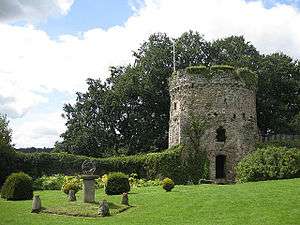Usk Castle

Usk Castle is a castle site in the town of Usk in central Monmouthshire, south east Wales, United Kingdom. It is a Grade I listed building as of 16 February 1953.[1] Within the castle, and incorporating parts of its gatehouse, stands Castle House, a Grade I listed building in its own right.
Location
Usk Castle is located immediately to the north of the present day town on a hill overlooking the streets and main Tywn square.
Early Norman castle
.jpg)
Usk castle and town was probably laid out and established in 1120, after some of the other Norman settlements and castles of the region, such as Monmouth Castle and Abergavenny Castle. However, the site had a history of previous military, strategic, and local significance, for it was here that the Romans had established their early Legionary fortress before relocating it south to Caerleon.
Usk is first mentioned in 1138 in the context of it being captured by the Welsh. It passed back into Norman hands, only to be captured by the Welsh again in 1174, as was Abergavenny, when turmoil again developed into open conflict in this area of the Welsh Marches.
Marcher lords
The Normans had to control and subjugate the region, and brought in Marcher Lord Richard Fitz Gilbert de Clare who sought to strengthen the castle's defences against Welsh attack, but he was ambushed and killed north of Abergavenny in 1136. The Welsh duly captured Usk castle again in 1184.
William Marshal was the next Marcher Lord to strengthen Usk castle. However, his conflict with King Henry III of England brought the Normans new headaches.
Gilbert de Clare, 7th Earl of Hertford, another holder of Usk castle, was killed at the Battle of Bannockburn when the English crown's focus was on defeating the Scots, and the castle was untroubled until the early 15th century. It was here, against this background, in 1352, that Adam of Usk was born.
Owain Glyndŵr
The rebellion of Owain Glyndŵr, between 1400 and 1405, brought significant conflict to the area once again, and the Welsh forces of Owain Gyndwr attacked Usk town in 1402. The Battle of Pwll Melyn was fought nearby, and the region only stabilised under the efforts of local Welsh warrior and ally of King Henry IV of England and Monmouth-born Henry V, Davy Gam.
Duchy of Lancaster
After the rebellion the castle passed to the Duchy of Lancaster, and, with stability restored, no further redevelopment or refortification was undertaken and the castle was allowed gradually to decay. It survived the English Civil War with only some slighting, and was eventually redeveloped when the gatehouse was adapted to a house in the 1680s.
Today

Today, the remains are quite substantial and include some interesting elements such as the dovecote tower. Although a private residence of the Humphreys family, events are held throughout the summer months.
The Early Medieval re-enactment group Regia Anglorum has borrowed the Castle for its Autumn training for the last 6 years.
Notes
- ↑ "Usk Castle and precincts – Usk – Monmouthshire – Wales". British Listed Buildings. Retrieved 2012-02-17.
External links
| Wikimedia Commons has media related to Usk Castle. |
- Castle Wales info on Usk plus photos
- Usk castle official website
- Bibliography of sources related to Usk Castle
Coordinates: 51°42′18″N 2°54′12″W / 51.7051°N 2.9033°W